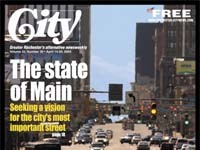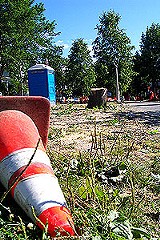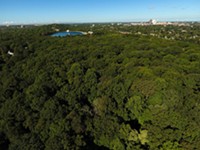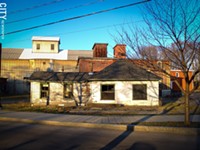[
{
"name": "500x250 Ad",
"insertPoint": "5",
"component": "15667920",
"parentWrapperClass": "",
"requiredCountToDisplay": "1"
}
]
Seven big trees went horizontal last week on the Rundel Park mall, victims of the desire for a wider street.
Rundel Park, a quiet non-thoroughfare just opposite the newly refurbished Atlantic-University intersection, is being upgraded with new curbs, pavement, and street lights. And its generously wide mall will be landscaped and reseeded. It's all part of the city's regular street maintenance and reconstruction schedule.
But there's a significant blip in the plan: The traffic lanes on either side of the Rundel mall are being widened --- from the current 15 feet to 17 feet. (There was even a possibility of 18 feet, but that option was clipped.)
The widening doomed the seven trees, all of them substantial. One of the trees was itself historic: a sugar maple around 125 years old, by our ring count. The old specimen made the fatal error of growing within a foot or so of the existing curb, which in American culture automatically gets the right-of-way.
Environmental Commissioner Edward Doherty says City Hall is just following the wishes of Rundel Park neighbors, though he admits that losing the trees is unfortunate. "There are trade-offs," he says, "but at least there was a high degree of community involvement on this one."
Doherty trains the light on traffic. "Vehicles were routinely driving on the mall," he says. The existing lane width, he says, was "substandard." There were complaints that vehicles parked on the street were getting sideswiped, says Doherty, and that emergency vehicles and snowplows sometimes had a tough time squeezing through.
Three options went before the Preservation Board, says Doherty. One option was a "mountable curb," an angled curbstone with a narrow paved strip inboard. This would have allowed vehicles to drive up over the curb without rutting the mall, as they have been doing informally. With this option, the lane width could have been kept to 16 feet, Doherty says. But the board, says Doherty, said no to the option.
"We've been working on this for five years," says Sandra Whitford, president of the Rundel Park Neighborhood Association. "When we had that terrible snow a few years ago, nobody could get in or out." Whitford adds that it's not just emergency vehicles, moving vans, and garbage trucks that have had trouble navigating the street --- it's also some SUVs.
The neighborhood group, says Whitford, originally wanted the mountable curb and 16-foot width, but went with a 17-foot compromise after the Preservation Board made its determination. In any case, she says, "they're going to put in new trees."
"It probably needed to happen," says the Landmark Society's Peter Siegrist about the widening and removals. Siegrist, who observed the vetting process, says the changes were needed to keep the neighborhood improving. "We need to get people to stay in those neighborhoods [as homeowners] for as long as possible," he says. What's happening now on Rundel Park, he concedes, "is not pure preservation."
But couldn't the street have been rebuilt while leaving the width at 15 feet, keeping the chain saws away from the trees? What about examples like Philadelphia's historic Center City, where some very popular streets aren't wide enough to allow cars at all, parked or moving?
"Leaving it alone was certainly an option, but the neighbors really wanted it improved," says Siegrist. "We can't compare ourselves to any of these larger cities," he says. In places like Philly, he says, commuting is difficult, and thus centuries-old streetscapes in the thick of things are in high demand (and home prices are in the seven figures).
Questions are emerging about the vetting process in this case. As Siegrist says, there were several opportunities for people --- on or off Rundel Park --- to put their two cents in. Yet the project, or at least the full dimensions of it, caught some people by surprise. City Newspaper learned of the tree-cutting via an anonymous call; the man, who said he was a Rundel Park renter, complained about the destruction of the trees and claimed that renters on the street were left out of the process. Some other Atlantic-University neighbors said they were shocked as well.
Due notice was given, say people close to the planning process. Yet even the City Hall website's official "street construction update" lacks some important details. The relevant notices mention "new pavement, new curb, driveway aprons, and receiving basins, spot sidewalk replacement; new street lighting system; and topsoil and seeding." The construction schedule appears, too, along with suggestions for parking during work hours. The notice contains nothing specific about lane-widening or tree removal.
But another kind of notice may be given: Such widenings and other "improvements" could be coming to other streets, that is, to other narrow, historic streets in the city's oldest neighborhoods. "The Arnold Park people," says Peter Siegrist, "have been watching this." The lanes on Arnold Park are a few inches narrower than the old, full 15 feet on Rundel Park.
Speaking of...
Latest in News
More by Jack Bradigan Spula
-

The state of Main
Apr 14, 2004 -
School improvement: the price is wrought
Apr 7, 2004 -
Hour of power
Mar 31, 2004 - More »









